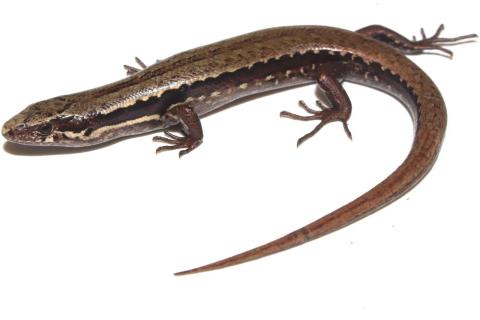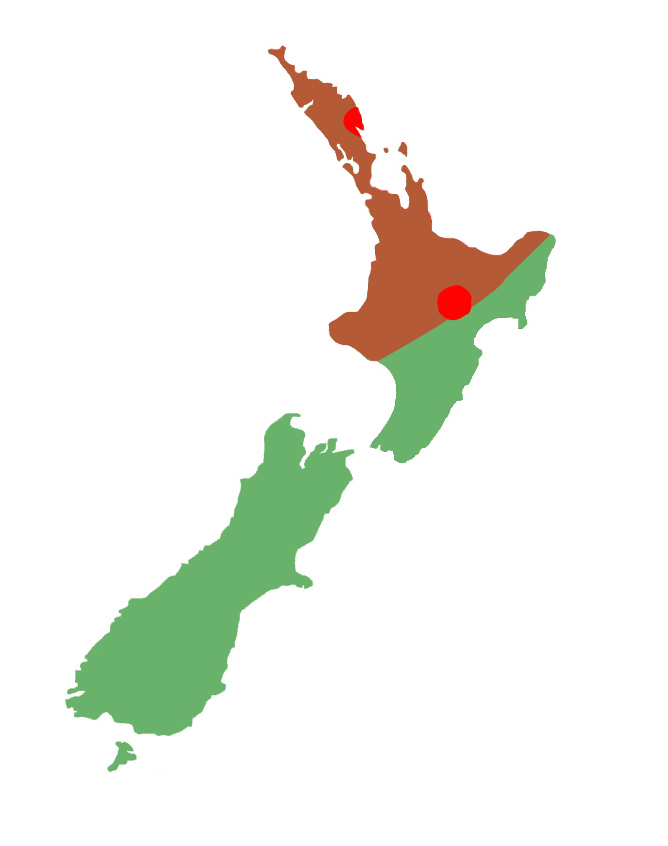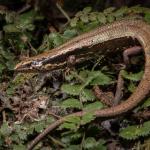- Home
- Herpetofauna Index
- Native
- Oligosoma Kakerakau
Oligosoma kakerakau
Kakerakau skink
Oligosoma kakerakau
(Barr et al. 2021)

Length: SVL up to 67mm, with the tail being longer than the body length
Weight: unknown
Description
Kakerakau skinks are a distinctive and bold little skink which eluded discovery until relatively recently. Similar in appearance to the closely related glossy brown skink (Oligosoma zelandicum), kakerakau skinks have brown dorsal surfaces sometimes with lighter and darker flecks, and a pale dorso-lateral stripe extends just past the forelimb. On the flanks, a broad dark-brown lateral stripe is bordered below by a light-cream stripe that breaks up beyond the forelimb. Their ventral surface is speckled and may be light-brown or deep red-orange. The head is short and blunt, with a distinctive tear-drop under the eye. Kakerakau skinks also have a prehensile tail which aids in climbing.
At Bream Head Scenic Reserve, kakerakau skinks co-exist with copper skinks (Oligosoma aeneum), ornate skinks (O. ornatum), moko skinks (Oligosoma moco) and rainbow/plague skinks (Lampropholis delicata) (Barr et al. 2021). Kakerakau skinks can be distinguished from these species by a combination of two features; a teardrop pattern under their eyes and distinctive mid-lateral stripes (Barr et al. 2021).
Life expectancy
Unknown.
Distribution
Kakerakau skinks have a disjunct distribution. They were originally discovered from a single specimen found inside a hut at Whirinaki forest in the central North Island, then subsequently detected at Bream Head Scenic Reserve in Northland (over 350km north from the original sighting). At Bream Head Scenic Reserve, kakerakau skinks are only found within a 1-2 hectare area within the forest (Barr et al. 2021).
In late 2022 a lizard found around Whangamōmona, Taranaki, was tentatively identified as this species. Although this is the northern extent of the closely-related glossy brown skink (Oligosoma zealandicum), several features suggest that it may not be this species. A genetic sample was collected for analysis.
Ecology and habitat
Kakerakau skinks are bold and strongly heliothermic. They occur in forest and scrub, where they can be seen basking and foraging on or near to the ground in forest clearings. Kakerakau skinks are mainly terrestrial, but are adept climbers and have been observed basking and foraging up to four metres above-ground on tree trunks and low vegetation (Barr et al. 2021).
The individual from Whirinaki forest was found inside a hut, located within podocarp, tawa and silver beech forest. The population at Bream Head occurs in clearings within coastal broad-leaved forest, scrub, and on rock outcrops.
Breeding biology
Unknown.
Diet
Little is known about the diet of kakerakau skinks. They feed on small invertebrates including flies, cockroaches, bees, and wasps (Barr et al. 2021). Presumably they also feed on the berries and fruit of native plants, in common with other species of New Zealand skink.
Disease
Unknown.
Conservation strategy
Extensive predator control is undertaken at Bream Head (the northern population for this species).
Repeated surveys at Whirinaki forest in the vicinity of where the species was first discovered have failed to detect further individuals.
Interesting notes
Kakerakau skinks are part of a clade which includes their sister taxon the glossy brown skink (Oligosoma zelandicum), as well as the chevron skink (O. homalonotum) and striped skink (O. striatum).
At Bream Head Scenic Reserve, kakerakau skinks exist syntopically with several other species of native skinks and rainbow/plague skinks. Interspecific aggression is rare, but has been observed between kakerakau skinks and rainbow/plague skinks (Lampropholis delicata).
The kakerakau skink, along with its sister taxon (the glossy brown skink) sit within clade 5 (the arboreal skink complex) of the Oligosoma genus, with the chevron skink, and striped skink being their closest relatives within the group.
References
Hitchmough, R.A., Barr, B., Lettink, M., Monks, J., Reardon, J., Tocher, M., van Winkel, D., Rolfe, J. (2016). Conservation status of New Zealand reptiles, 2015; New Zealand threat classification series 17. Wellington: New Zealand Department of Conservation.
Jewell, T. (2011). A photographic guide to reptiles and amphibians of New Zealand. Auckland: New Holland Publishing.
van Winkel, D., Baling, M. & Hitchmough, R. (2018). Reptiles and Amphibians of New Zealand: A Field Guide. Auckland: Auckland University Press, 376 pp.
Kakerakau skink basking on forest floor (Whangarei, Northland). © Nick Harker


